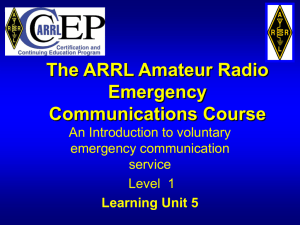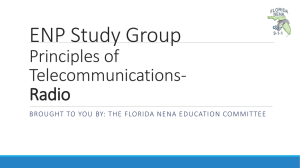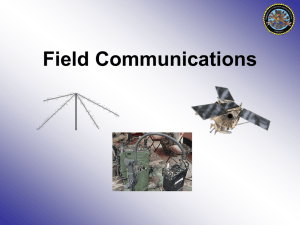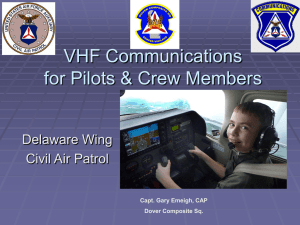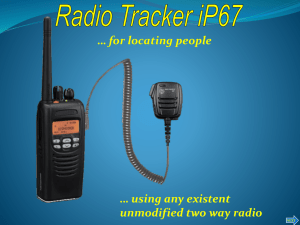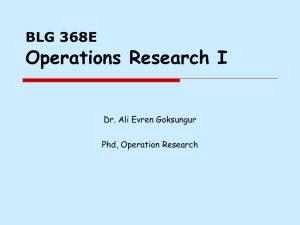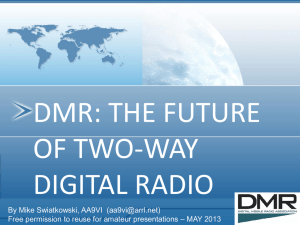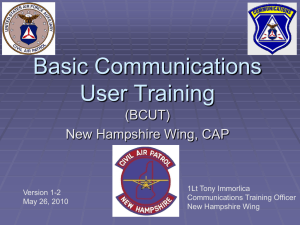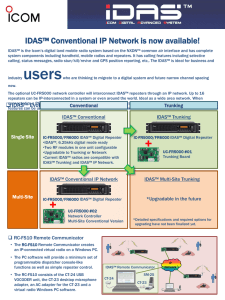Can you Hear Me Now???
advertisement
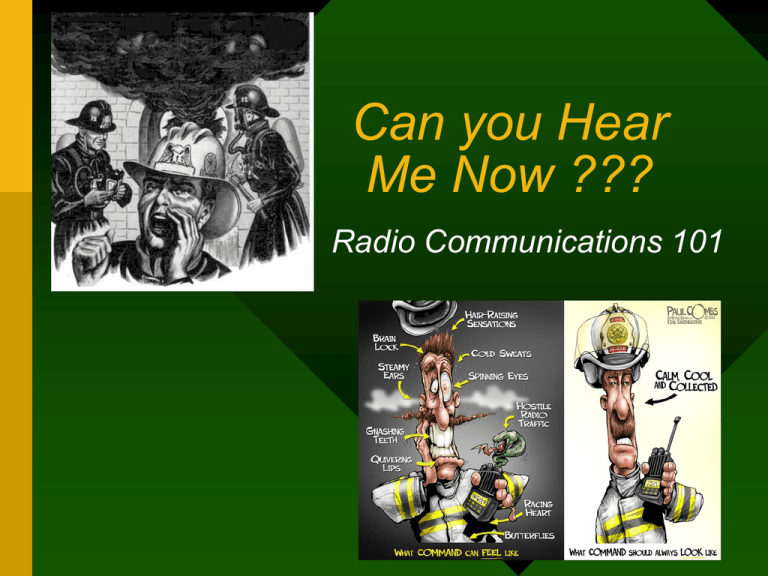
Can you Hear Me Now ??? Radio Communications 101 Communications and Radios • The bread and butter of how we communicate. – Radio Frequencies – Wide Band vs. Narrow Band – Base Stations / Repeaters – Simplex Operations – Trunking vs Conventional – Cross Band Repeaters – MABAS IFERN Interoperability – MARC Interdisciplinary Frequencies – xCALL/xTAC State and Federal Interoperability – WISCOM So, what does it boil down to? •Fire departments rely heavily on two-way radios to communicate between companies, departments, and other disciplines at emergency and disaster scenes. Fire Departments utilize radio frequencies in the VHF-Low, VHF-High, UHF and 800 MHz frequency bands for day-to-day operations. Newer technologies include the use of analog and digital transmissions and trunking technologies using incompatible protocols. •While these systems may meet the routine needs of individual departments, experience has shown that lack of interoperability between companies operating at an emergency scene can lead to serious and potentially life threatening consequences. •The FCC’s national radio frequency band plan specifies four VHF-High Band radio frequencies for fire service interoperability and fireground operations. There are also five analog public safety mutual aid frequencies in the 800 MHZ band plan. The state of Wisconsin has identified the frequencies of Mutual Aid Radio Channels (MARC) as a statewide, interdisciplinary, coordination channels for use by police, fire, EMS, and other governmental agencies. •Departments that utilize frequencies other than VHF-High Band for primary operations have developed various systems to communicate with MABAS departments at mutual aid calls. These systems include cross-band mobile repeaters and console patches to VHF base stations. These systems have many limitations, have tendencies to cause harmful interference, limit operating areas, may violate FCC rules, and could jeopardize the safety of personnel at emergency scenes. •NFPA standard 1221, Standard for the Installation, Maintenance, and Use of Emergency Communications Systems, Section 6-3.1.3 and 6-3.1.4 recommend that, “A simplex radio channel shall be provided for on-scene tactical communications” and “Communications system design shall be such that a portable radio is capable of operating properly within the dispatch area without the use of mobile radio frequency (RF) amplifiers”. •MABAS and the Wisconsin Emergency Management (WEM) have entered into an agreement to provide disaster response statewide. The potential exists for fire and EMS units to be operating for extended periods of time several hundred miles from their local jurisdiction or other distant jurisdictions may be operating in a stricken community during a disaster. Common mutual aid operations and fireground frequencies that will function statewide are essential. • The Federal Communications Commission (FCC) has designated four 12.5 kHz “narrow band” frequencies, three of which are for inter-system operation. As fire departments migrate to newer “narrow-band” two-way radio equipment, the four additional VHF fire frequencies could be integrated into MABAS’s overall communications plan. Understanding Radio Frequencies VHF 150 Wave height impacts the ability of a radio signal to penetrate or leave a building. The higher the frequency the greater the ability to penetrate a building. However the higher the frequency the less wattage available to push the signal along to a base station or repeater. 150 6.56 155 6.34 450 2.18 470 2.09 780 1.26 800 1.23 806 1.22 851 1.15 900 1.09 2400 0.41 5800 0.169 11000 0.089 Wide Band vs Narrow Band • FCC directive issued 12 years ago to narrow band radios. • All radios had to be narrow banded by January 1, 2012 • Go from 25 hz spacing to 12.5 hz spacing between frequencies. In the future will see 6.25 hz spacing. • Half the volume (think water), same amount of power (think pressure) • About a 21% loss in coverage. If you had marginal coverage before narrow banding it was abundantly clear after narrow banding where your coverage gaps were. • Increased the availability of frequencies – doubled the number of available frequencies especially in VHF • Issues with wide band pagers Terrain Coverage Issues Terrain Coverage Issues Terrain Coverage Issues Base Station / Repeater Operation • Base Stations & Repeaters are designed to be located at high sites – Antenna masts, water towers, or other very high locations. (125 to 200 ft above ground) – Repeaters uses two frequencies – one in and one out – Ability to hear weak signals due to receiver height – Ability to rebroadcast signals over a broader area – Use of voting receivers to enhance coverage (signal to noise ratio selects the best available signal in an analog system) – Spin-up time for the Repeater (100 to 400 ms) – Input audio from the voter (comparator) should go direct to the console - helps dispatchers hear field units before the audio is repeated – Base Stations use same frequency to transmit & receive. Repeater Operation (Conventional System) BASE TRANSMIT FREQUENCY (Mobile Receive) = 460.0125 MHz MOBILE TRANSMIT FREQUENCY (Mobile Transmit) = 465.0125 MHz Repeater System (Conventional System) BASE TRANSMIT 460.0125 REPEATER SYSTEMS UTILIZE ONE FREQUENCY TO TRANSMIT AND ANOTHER FREQUENCY TO RECEIVE. MOBILE RECEIVE 460.0125 MOBILE TRANSMIT 465.0125 Repeater System (Conventional Satellite Receiver System) Satellite Receiver 465.0125 Microwave or T1 Telco Link 465.0125 460.0125 465.0125 Microwave or T1 Telco Link Satellite Receivers Microwave or T1 Telco Link Simplex Operation • Radio to Radio communications without any other assistance – Also called Talk Around – Transmit and Receive on a single frequency – Handhelds have a limited range (3 to 5 watts) – Mobiles have a greater range (10 to 50 watts) – No delay in key ups – Many operational and interoperability channels available. – Simplest of all fire ground channels with the least amount of technology between the firefighters and Command – Command MUST always use a mobile radio when utilizing IFERN – IFERN base stations are generally single base station sites WITHOUT the benefit of voting receivers. Simplex Operation Base & Mobile radios utilize the same frequency to transmit and receive. TX = RX = 453.4000 for all radios. Trunking vs Conventional Systems A trunked radio system is a complex type of computer-controlled two way radio system that allows sharing of relatively few radio frequency channels among a large group of users. Instead of assigning, for example, a radio channel to one particular organization at a time, users are instead assigned to a logical grouping, a "talkgroup". When any user in that group wishes to converse with another user in the talkgroup, a vacant radio channel is found automatically by the system and the conversation takes place on that channel. Many unrelated conversations can occur on a channel, making use of the otherwise idle time between conversations. Each radio transceiver contains a microcomputer to control it. A control channel coordinates all the activity of the radios in the system. The control channel computer sends packets of data to enable one talkgroup to talk together, regardless of frequency. From Wikipedia, the free encyclopedia Trunking Systems (Basic Operation) http://en.wikipedia.org/wiki/Trunked_radio_system • Control Channel for each site. Data packets from field units are sent to the trunking system over a dedicated channel. Based on the radio ID that will determine the capabilities of the mobile/portable radio user (subscriber) on the system. • Talk Groups – Analogous to radio channels within a trunking system. • Operation – Push-to-talk. Mobile/portable requests a talk grant on a trunking system. Data sent over the control channel. If the mobile/portable radio is authorized on the system, and authorized on the talkgroup the radio receives a talk grant. Then all radios on the trunking system with the same talk group are notified about the impending transmission, and a frequency pair are assigned. Every time you initiate a PTT transmission there is a high probability your radio traffic will go out over a different frequency pair. Trunking Systems (Basic Operation) http://en.wikipedia.org/wiki/Trunked_radio_system Trunked radio takes advantage of the probability that with any given number of user units, not everyone will need channel access at the same time, therefore fewer discrete radio channels are required. From another perspective, with a given number of radio channels, a much greater number of user groups can be accommodated. In the example of the police department, this additional capacity could then be used to assign individual talk groups to specialized investigative, traffic control, or special-events groups which might otherwise not have the benefit of individual private communications. To the user, a trunking radio looks just like an "ordinary" radio: there is a "channel switch" for the user to select the "channel" that they want to use. In reality though, the "Channel switch" is NOT switching frequencies as in a conventional radio but when changed, it refers to an internal software program which causes a talkgroup affiliation to be transmitted on the control channel. This identifies the specific radio to the system controller as a member of a specific talkgroup, and that radio will then be included in any conversations involving that talkgroup. Technology…. Be careful and always test your coverage for interior ops! Trunking Systems (Basic Operation) http://en.wikipedia.org/wiki/Trunked_radio_system • Types of Trunking Systems – Open Sky – City of Milwaukee – Motorola Type 2 Analog – Milwaukee County (Updating to APCO P25) – Motorola APCO P25 Digital – Waukesha County – EDACS – Ozaukee County – LTR – Logic Trunked Radios (Generally business systems) – EF Johnson APCO P25 Digital – State of Wisconsin (WISCOM) – TETRA (Terrestrial Trunked Radio) – TDMA primarily in Europe – iDEN (Integrated Digital Enhanced Network) - Nextel Cross Band Repeater (Motorola RICK HLN-3333) • Designed to be mounted in a vehicle to connect separate radio bands together – Connect any VHF/UHF/800 fire ground frequency to any other VHF/UHF/800 fire ground frequency. – MUST MAKE SURE radio is not in scan – Select the two channels to be connected – Push the button – green light on RICK comes on – MUST MAKE SURE THE RICK IS OFF when done – Somebody MUST ALWAYS monitor the crossband patch. Cross Band Repeater (JPS Raytheon ACU-M) • Interconnects 4 audio ports, 2 VoIP channels and a local operator • Can interconnect radios in any band including HF, VHF, UHF, P25, 800Mhz and Nextel iDEN phones • Simple, intuitive interface used for diagnostics, programming and feature control • Optional network connectivity that can be controlled via WAIS Controller Software • Compatible with existing ACU radio interface cables • Internal pre-configured radio template library for all supported devices • Can be installed in a vehicle, in a rack, or in a Pelican case • Powered by battery, vehicle +12 outlet, 120 VAC IFERN MABAS Frequencies (VHF) • Simplex frequencies for Mutual Aid – IFERN – Primary Mutual Aid Dispatch Channel – IFERN 2 – Secondary Base Channel – RED FG is a primary operational channel – WHITE FG – secondary operational channel – BLUE FG – Water Supply or EMS – GOLD FG – tertiary operational channel – BLACK FG – tertiary operational channel – GRAY FG – tertiary operational channel – GREEN FG – NOT AUTHORIZED in Wisconsin – Strongly urge all counties especially near the Illinois Border to start planning for the implementation of IFERN 2 MARC Channels (VHF) • MARC 1 is the Statewide mutual aid repeater. Each county has one MARC 1 repeater which must be turned on when requested. • Used for large scale incidents requiring county wide interoperability communications – MARC 2 is the simplex version of this channel and is also to be used when contacting Flight for Life. – Marc 3 & 4 are simplex operational channels – Fire and Police agencies have these frequencies programmed in their radios. – To be used by the Racine County Dive Team xCALL / xTAC Nationwide Interops (VHF, UHF and 800) • xCALL and xTAC are nationwide interoperability frequencies can be used when an incident requires assets from the State of Wisconsin or the Federal Government. Potential to use locally as well. – VCALL10 is the VHF (150 MHz) calling channel to establish contact. VTAC 11 through 14 are simplex channels for on scene communications with various assets. – UTAC 40 is the UHF (460 MHz) calling channel with UTAC 41 through 43 can be used in repeated or simplex mode. – 8CALL90 is the 800 MHZ calling channel with 8TAC91 through 94 can be used in repeated or simplex mode – 8TAC RED, 8TACWHITE, and 8TACBLUE are statewide simplex interoperable channels on 800 MHz. NIFOG National Interoperability Field Operations Guide The Office of Emergency Communications (OEC) publishes the National Interoperability Field Operations Guide (NIFOG) as a reference guide for public safety radio technicians and communications planners. The waterproof, pocket-sized guide (also available in PDF format) contains radio regulations, tables of radio channels, and technical reference information. This guide is ideal for those establishing or repairing emergency communications in a disaster area. http://www.dhs.gov/national-interoperability-field-operations-guide WISCOM Statewide Interoperability The Wisconsin Interoperable System for Communications (WISCOM) is a shared system that first responders in communities across the state will use to communicate during a major disaster or large-scale incident. WISCOM will support up to four simultaneous conversation paths during an incident, dramatically increasing the current capacity available with statewide mutual aid channels and allowing responders from any area of the state to assist another community without losing communication capabilities. Currently there are about 90 sites across the State of Wisconsin. Available talkgroups include eight statewide SCALL/STAC channels, four RCALL/RTAC channels in each WEM region, MABAS 1, MABAS 2, Haz Mat, Collapse, and EPS. WISCOM is designed for 95% statewide MOBILE coverage ONLY! There are areas of the state where there is good or great portable coverage, however we CANNOT rely on portable coverage for interoperability. Test your portable coverage. Things to think about… • Console Patches to IFERN from 800 Systems – Avoid if at all possible. Consider implementing IFERN 2 in your dispatch centers. • Intra-Divisional or Intra-radio system responses without IFERN • Developing and Implementing a Tactical Interoperable Communications Plan (TICP) • Create and Implement the ICS 205 radio communications plan and practice the plan regularly (at least quarterly) • Consider adding WISCOM mobile radios to your Mutual Aid Apparatus • Consider adding WISCOM mobile radios to your ambulances for patient reports to the hospitals. Most hospitals in Wisconsin now have WISCOM base stations.
